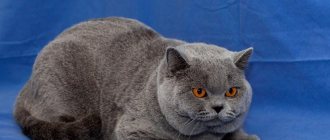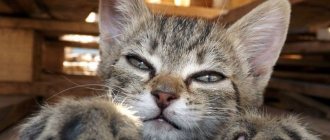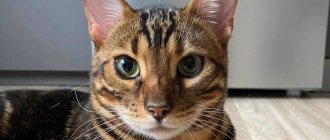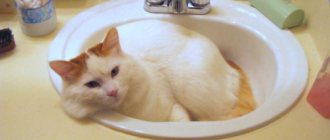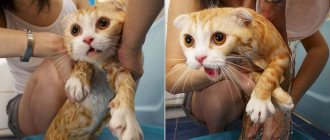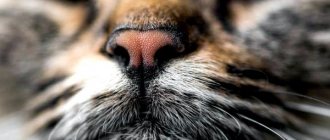Brief history of the breed
Türkiye, or more precisely Eastern Anatolia, is considered the homeland of Van cats. Although they have existed since the Middle Ages, the world felinological community learned about them only in the 50s of the last century. In 1955, English correspondent Laura Lushington and photographer Sonia Halliday saw white shaggy cats with fiery red spots on their heads and tails in Turkey. The girls liked the unusual animals, and local residents gave them a couple of kittens.
On the way to the airport, the engine of the English women's car overheated, and they were forced to stop. When Laura and Sonya went down to the stream, they were surprised to see that the kittens not only followed them, but also began to swim in the water.
Upon returning to their homeland, the girls registered their pets as Van Atilla and Van Guzelli Iskenderun. It was with them that the breeding of the Turkish Van cat in Europe began. In 1979, the breed received official recognition from TICA. And in 1994, the Turkish van was registered by the CFA.
A bit of genetics
Two basic colors are responsible for the entire rich color palette of cat colors (except white):
- black;
- red.
They are formed under the influence of the pigment melanin, which includes two chemical varieties:
- zumelamine - gives the coat a black color;
- pheomelamin - produces red color.
The genes responsible for the appearance of red (O - orange) or black (o - not orange) are located on the X chromosome:
- cats have two X chromosomes (XX);
- Cats have one X chromosome and one Y chromosome (XY).
The kitten inherits one chromosome from each parent: from the mother - X, from the father - X or Y.
Just like in humans, female cats have a set of XX chromosomes, and males have XY chromosomes.
Three colors that a cat can have:
- OO - red;
- oo - black;
- Oo - tortoiseshell.
If both X chromosomes contain O, the cat will be red, if O, it will be black, and if Oo, the cat will be two-colored.
For a cat that does not have the O gene on the Y chromosome - OY or oY. Accordingly, cats can only be red and black. Tortoiseshell cats appear only as a result of a gene failure and are almost always sterile.
If the parent X chromosome carries the O gene, the cat will be red, and if O, the cat will be black.
The white color stands apart. Rather, it is not even color, but the absence of pigment.
Genetics of black and white color
The black and white cat's coat is called black bicolor (two colors). Bi-colored cats are sometimes called meglais, from the English "magpie."
The bicolor color was recognized by European associations in 1969. After this, an active period of breeding bicolor cats began. Before this, pets with double colors were considered a genetic defect.
The dominant S gene is responsible for spotting in cats. Sometimes it works so actively that the white spots on the coat merge into one continuous spot, and the animal becomes completely white. If the gene is not expressed in full force, two-color colors are obtained.
Piebald color can be inherited, with the location and size of the spots changing.
Even in the same litter, kittens with the same bicolor color are not born. Each fur pattern is individual, just like the papillary pattern on a person’s fingertips.
To get a meglaye litter, breeders mate two bicolor parents or a black and white cat with a tortoiseshell cat.
Interesting Facts
Over the entire existence of the Turkish Van, many interesting things have been associated with this breed of cats:
- The image of these animals often appears in art. Thus, the Armenian classic Raffi described Van cats in his novels “Sparks” and “Diary of a Cross Thief.” And the famous playwright and writer Vrtanes Papazyan dedicated a short story “Vana Kata” to them.
- In Turkey there is a beautiful legend about Van cats. According to it, a mouse was launched onto Noah's Ark and was given the task of making a hole in the bottom. Fortunately, there was a white cat there, which caught the rodent. In gratitude for his help, God touched the animal, and red spots remained on its body. The Turks call these cats o, and the cats themselves are valued and protected.
- In their homeland, representatives of the breed are called “vana katu”, which translated from Turkish means “cat from Lake Van”.
Standard color requirements
A common requirement for all cats of this type (van, bicolor, tricolor, harlequin) is a clear separation of spots of different colors on the surface of the fur. That even a white hair should not penetrate the painted area. Based on these requirements, the pattern on wool looks like a colored mosaic of archaically arranged elements. The nose and pads on the cat's paws are colored according to the main color of the fur coat. The rich golden-orange color of the eyes indicates a high percentage of coloring pigment in the cornea.
British Shorthair from 01 62
Highland fold red harlequin – SFL d 02
Breed description, standards, appearance
Van cats are athletic, harmoniously built animals with developed muscles and a bushy tail. A detailed description of the Turkish Van breed is presented in the official standard, which was adopted by the international felinological community in 1994.
Dimensions and weight
Representatives of the breed are quite large in size. The length of their body together with the tail is about 0.9-1.3 m with a height of up to 40 cm at the withers.
An adult Van cat weighs about 9-10 kg. The cat's weight reaches 5-6 kg.
Anatomical characteristics
A typical Turkish van should fit the following description:
- The head is wedge-shaped, with a neat, rounded muzzle, a smooth profile, developed cheekbones and a strong chin.
- The ears are large, set far back, with a wide base and a straight outer edge.
- The eyes are large and oval. Planted at a barely noticeable angle, slightly elongated towards the corners. The iris of Turkish Vans can be blue, amber or copper. The breed often contains cats with heterochromia.
- The body is strong, elongated, with developed muscles, broad shoulders, a round chest and a short muscular neck. No angularities or straight lines.
- The limbs are strong, of medium length, with neat round paws, pink pads and tufts of hair in the interdigital space. The hind legs of the Van cat are slightly shorter than the front ones.
- The tail is of medium length, with good feathering. Visually resembles a brush or train.
Color and coat type
Van cats are semi-long-haired animals without a pronounced down. The shoulders of Turkish Vans are covered with shorter fur. On the tail and back of the body of representatives of the breed, the hair is noticeably longer.
Most Turkish cats have the classic Van coloring. Such animals should have a snow-white body, a chestnut-red tail, and red markings on the muzzle and at the base of the ears.
Character and temperament
The Turkish Van is a gentle and friendly cat that quickly becomes attached to people. She is very emotional and sensitive to the mood of her owners. The Van cat unmistakably senses the beginning of a conflict and tries to extinguish it like a real peacemaker.
The patient and friendly animal gets along well with children and enjoys playing with them. It should be remembered that the Van cat does not like to be squeezed and stroked against its will. Therefore, she can scratch and even bite an overly annoying child.
The Turkish Van easily gets along with other cats and dogs. But it’s better not to introduce him to fish, birds, reptiles and rodents.
How to choose the right kitten
Buying a Turkish Van is complicated by the fact that it is a fairly rare breed. The few nurseries specializing in breeding these cats are concentrated in Europe and America. And in the homeland of the Van, there are restrictions on the export of breeding individuals outside of Turkey.
Important! To avoid becoming a victim of scammers, you should only buy a Turkish Van kitten from a reputable nursery and draw up an agreement. Together with the baby, the owner must receive documents that display information about his ancestors and vaccinations.
The Van kitten is easy to distinguish by its unique coloring and coat quality. And his health can be indirectly judged by his good appetite, active behavior, clean ears and soft belly.
Kitten care
Not a single reputable nursery will hand over a Van kitten into the hands of its owners before it turns 12 weeks old. By this age, Turkish children are already fully socialized and adapted to independent living.
Typically, three-month-old Van kittens already know how to use a tray and a scratching post. This means that new owners will not have to teach their pet basic skills. You just need to give the kitten the opportunity to get acquainted with the new home and set the limits of what is permitted.
Important! To prevent the Van kitten from being injured, wires, breakable objects, detergents and flowerpots with ornamental plants are hidden in the house in advance. Also, for safety reasons, the animal is restricted from accessing large household appliances, open balconies and open windows.
Diseases
Since the Turkish Van is an aboriginal breed, they have fewer genetic pathologies than hybrid breeds. However, health problems still arise. Let's list the main ones:
Hypertrophic cardiomyopathy is an insidious disease that, unfortunately, cannot be completely cured, but can be “suppressed” and alleviate the pet’s general condition. It is expressed in thickening of the left cardiac ventricle and the septum between the ventricles (while the ventricular cavity itself is greatly reduced).
The disease occurs more often in males: the animal becomes more lethargic, suffers from shortness of breath, tachycardia, breathes heavily, and a murmur is heard in its heart. Pulmonary edema gradually increases, fluid accumulates in them, pressure increases, and partial paralysis occurs. The cough is completely absent. Catalyst: prolonged stress, illness, infusion therapy carried out without proper calculations of the speed and volume of fluid. Treatment is medication; in severe cases, it occurs in a hospital.
The weakest point of the Turkish Van is the gums and teeth. The gums often become inflamed, and tartar builds up on the teeth. Other diseases also appear. Therefore, it is important for you to monitor this from the very beginning: choose the right care products, brush your teeth regularly, and regularly take your animal for examination to the veterinarian.
Expert opinion
Dusheba Vera Ivanovna
In 2010, she graduated from the Moscow State Academy of Veterinary Medicine named after K.I. Scriabin with honors, specializing in veterinary medicine. I regularly attend veterinary conferences, congresses, and webinars.
Do not refuse vaccination, even if your cat is indoors and, in your opinion, is completely protected. This is not true: pathogens of such dangerous diseases as panleukopenia, rhinotracheitis and others easily enter your home on clothes or hands.
Care and maintenance
The Turkish Van must be protected from drafts, cold and dampness. Otherwise, caring for a representative of the breed differs little from that for any other semi-long-haired domestic cat.
Hygiene procedures
In order for the Turkish van to have a neat appearance, it is provided with appropriate care:
- To prevent tartar and other dental problems, cat teeth are brushed with a soft silicone brush with a small amount of non-foaming paste. The procedure is carried out 2-3 times a week.
- The ears of the Turkish Van are periodically cleaned from accumulated dust and dirt. To do this, a special product is instilled into each of them and after a few minutes they are wiped with a moistened cotton pad.
- The eyes of a Van cat are treated daily with a piece of natural fabric moistened with a herbal decoction or boiled water.
- The claws of the Turkish Van are shortened with a nail clipper as they grow. Only the transparent ends can be cut off.
Grooming
The fur of the Turkish Van does not tangle and is easy to comb with a comb. In normal times, it is enough to do this 2 times a week. During the molting period, the Van cat is scratched daily.
Representatives of the breed are bathed no more than 3-4 times a year. To do this, the water-repellent coat of the Van cat is thoroughly moistened, lathered with mild shampoo and rinsed thoroughly. At the final stage, the animal is wiped with a terry towel.
Tray
A Turkish bath needs a spacious tray with high sides. The type of litter depends on the individual preferences of the cat. The only thing that experienced breeders do not recommend using is wood shavings, particles of which stick to the tail and paws of the animal and are spread throughout the house.
On a note. The Van cat is very clean and will not go into a dirty litter box. Therefore, it is advisable to install a spare toilet for her.
Breeding work
Like all large cats, the Turkish Van matures slowly - the animal is fully formed only by the age of three, or even five years. Therefore, you should not be too hasty with mating, especially in cats: early motherhood can negatively affect the health and psyche of an immature animal.
Interestingly, kittens of this breed, on the contrary, develop very quickly - they, for example, open their eyes already on the third day of their life!
Obtaining high-quality offspring is the main task of breeding work
Breeding
The gene pool of Turkish Vans in Europe is extremely small, and the choice of a partner can often depend on closely related ties. Therefore, to obtain high-quality offspring, the most important issue is the correct selection of a breeding pair - however, as always in breeding. A newbie divorcer is often unable to solve this problem on his own. Rely on the experience and knowledge of your breeder, who cares about the prospects of the breed and will be able to advise you on the best options.
As far as possible, trace the heredity along both parental lines - find out if there were any serious defects or genetic diseases in them:
- deafness in white cats;
- curvature of the jaw;
- creases and kinks in the tail;
- color marriage.
Producers must reach reproductive age (at least two years), be absolutely healthy and prepared for mating: have timely vaccinations and antiparasitic treatment.
Breeding success begins with the proper selection of parent pairs
The physiology of a cat allows it to become pregnant and give birth three or even four times a year. But in practice, this cannot be allowed - the cat must be able to fully recover during the period between births, and this requires time. The optimal frequency of effective matings is three times in two years.
Sterilization issues
If the Turkish Van will not be used for breeding, then it is better to sterilize such an animal - both male and female. Removing the genitals will help solve several serious problems at once:
- normalize hormonal levels;
- reduce the level of aggression and excessive activity;
- avoid possible cancer and genital diseases.
Before sterilization, the cat must undergo a medical examination
Often, when selling a pet-class kitten, breeders make its subsequent sterilization a mandatory condition - individuals that do not meet the high requirements of the breed standard should not participate in breeding, thereby reducing the overall quality of the Turkish Van population.
But it should be remembered that sterilization is by no means a harmless manipulation, but an operation (for a cat - abdominal), which takes place under general anesthesia. Therefore, it is extremely important that sterilization of the animal is carried out by experienced specialists and not at home, but in a veterinary clinic. Veterinarians will take control of the Van’s rehabilitation after surgery, which is no less important than a successful operation.
A feature of sterilization of the Turkish Van is the late maturation of representatives of this breed, which must be taken into account when determining the optimal timing of the operation. If cats and cats of other domestic breeds are usually sterilized immediately after puberty, then Vans should wait a bit in this matter - otherwise the animal will stop growing and developing. It is customary to sterilize female Van breeds at the age of one and a half years, and males - no earlier than a year.
Video: how to care for a cat after sterilization
Feeding the cat
To maintain good health and physical activity, the Turkish Van needs a balanced diet enriched with protein. Cats of this breed eat both commercial and natural food well. Therefore, the right of choice remains with the owner.
Complete diet
With an industrial type of nutrition, the Van cat is given premium or super-premium drying, which contains the entire range of minerals and vitamins. When choosing food, it is important to pay attention that it does not contain soy, corn, wheat, dyes and other additives of little use. Products from the following brands are best suited for a Turkish van:
- Royal Canin;
- Arden Grange;
- Pro Plan;
- Pronature;
- Hills.
With a natural type of nutrition, fresh, lean meat should predominate in the Van cat’s diet. She is also given cereals, eggs, vegetables, offal, ocean fish and dairy products.
To keep the Turkish Van healthy longer, pork, bones, sweets and sausages are excluded from his menu. Also, the animal is not given river fish, baked goods, starchy vegetables, whole milk and any food from the owner’s table.
Feeding frequency
When drawing up a feeding schedule, it should be taken into account that Turkish Van kittens eat less, but more often than adult representatives of the breed:
- up to 3 months – 5-6 times a day;
- 3-5 months – 4 times a day;
- 5-12 months – 3 times a day.
A one-year-old Turkish Van is being given two meals a day.
Vitamins and minerals
Van cats that eat natural food may lack nutrients. To compensate for the deficiency of vitamins and minerals, they are given special supplements twice a year.
Important! An excess of microelements is just as dangerous as a deficiency. Therefore, before introducing vitamin-mineral complexes into the Turkish Van’s diet, the cat is shown to a veterinarian.
Nutrition
The cat has long been accustomed to obtaining food on its own, so the newly arrived kitten should be trained to eat only from its own bowl.
Of course, a curious van will still try to snatch a piece from the common table or at least check what the owners are eating.
The best option for feeding an animal would be premium food for active pets.
Seafood and sea fish are ideal natural foods for vans.
A cat will never refuse an extra portion of food, but it should not be overfed.
Education and physical activity
Van cats are active and temperamental animals. They love to run, jump and walk. In the warm season, it is advisable to regularly take them out into the yard. And to maintain physical fitness at home, they will be equipped with a “sports” corner with multi-level shelves and ladders.
On a note. The Turkish Van is not afraid of water and loves to splash around in it. Therefore, in the summer, you can equip your cat with a small pool where she can swim.
The Turkish Van is a highly intelligent and intelligent animal that is easy to train. A cat of this breed gets used to the litter box without any problems and quickly remembers the rules of behavior in the house.
Vaccinations and antiparasitic treatment
To prevent infectious and viral diseases, the Turkish Van is subject to routine vaccination. At the age of 7-8 weeks, the kitten is vaccinated with a complex drug that activates the development of stable immunity to rhinotracheitis, calcivirosis and panleukopenia.
After 28 days he is vaccinated against the same diseases and against rabies. In the future, a cat of this breed is vaccinated once a year.
To prevent infection with diseases carried by parasites, the Turkish Van is systematically treated for fleas and worms. Anthelmintic drugs are given to the cat twice a year with mandatory repetition after 10-14 days.
To combat fleas, the Turkish Van is treated with special drops or shampoos. And if the cat is outside, an anti-parasitic collar is put on it.
Pros and cons of the breed
The Turkish Van, like a cat of any other breed, has not only advantages, but also disadvantages:
| pros | Minuses |
| Pleasant appearance | Rarity of the breed |
| Easy to care for | High cost of kittens |
| High intelligence |
Van cats are beautiful animals with luxurious semi-long hair of a unique color. They have a playful nature and make excellent companions for those who are willing to give them enough time and attention.
GALLERY OF PHOTOS OF BRITISH CATS, CATS, KITTENS OF COLOR BI-COLOR, HARLEQUIN, VAN, TRI-COLOR
Lilac color with white British cats. Lilac bicolor British
Red (fawn) color with white British cats. Red (fawn) bicolor British
| In our cattery you can “buy a real British kitten.” We have many different colors, we will help you choose and answer all your questions! |


